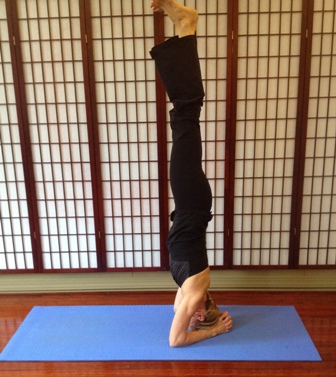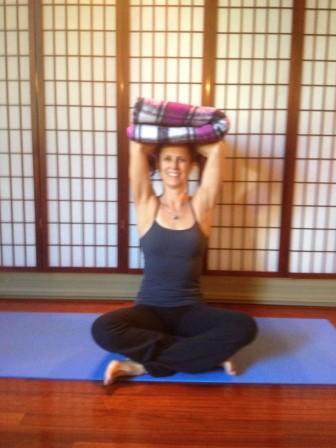Sirsa means head, Asana means posture. This posture is head posture or Headstand.
One time, many years ago, my doctor was asking me about my yoga practice. I was suffering from headaches and I told him that if I did my yoga practice and did Headstand, that my headache would go away. He told me that if God wanted us to stand on our heads, he would have built us upside down. I decided to not talk to my doctor about my yoga practice anymore. He couldn’t understand why on earth anyone would want to stand on their heads.
As a yoga teacher, I realize that Headstand is not for everyone. But I like to do it, and I feel that it helps me focus, gain clarity and get a new perspective on things. If you look in Light on Yoga, Mr. Iyengar will tell you that it is good for a lot of other things as well. He calls it the King of all Poses. He says that its mastery gives one balance and poise, physically and mentally. And it used to help a lot with my headaches! In yoga we regularly engage our bodies in different relationships to gravity to help build strength, awareness and integration. As part of my Iyengar yoga practice, we did Headstands regularly. I think regularly is an important word here. I don’t think doing random Headstands is a good idea. And I think that students who come in new to an ongoing class should be patient and wait until they are ready and strong enough to do Headstand.
How do you know that you are ready and strong enough to do Headstand? First, the idea of doing Headstand doesn’t strike fear into your heart. Doing a pose with fear causes you to contract. Moving into any pose with fear and contraction is not good. Second, that you have no neck issues to start with. Third, your neck is strong. Lastly, you know how to muscularly engage your body to make it strong and stable, not loose and floppy. Mr. Iyengar often describes this as being “poker stiff”. Stiff is not often a word you would associate with yoga, but it means that one part won’t sag, think of the whole body as being engaged. Sagging in Headstand, especially in the neck is not desirable.
As we work on Headstand this month, I would like to offer a few alternatives for those of you who might not be ready to go upside down. First, let me say that I am not a big fan of Legs-up-the-Wall Pose as an alternative for Headstand. Headstand is a fiery pose, it heats you up, and it demands a lot of energy. Legs-up-the-Wall-Pose is not a fiery pose, it is cooling and it does not demand any energy. It is very relaxing. It is a good alternative for Shoulderstand, but not Headstand. If you are doing an alternative pose, it should be form-wise and energy-wise related to the main pose. Here are some suggestions for alternatives to Headstand:
Sitting or standing upright, with your hands clasped behind your head (like Headstand), supporting a blanket on your head and forearms. (This is more taxing than it looks!) (Sorry the picture is out of focus. I’ll have to take a new picture!)
Doing “Airplane” on your knees, with your head into the wall.
Doing Dolphin Pose.
Dolphin Pose
Horizontal Headstand. This is where you are supine with a block under your head, your shoulders and your heels. You press into your heels and lift your buttocks off the floor. To make this feel even more like the real thing, interlace your hands behind your head and draw your elbows towards each other so that they are shoulder width apart.
(Sorry, I don’t have a picture of this one, yet.)
You may wonder how come I don’t mention right angle Headstand (like right angle handstand). The simplest explanation is that if you are not perfectly vertical in Headstand, then the angle will put strain on your neck. This is less critical in handstand where you adjust your shoulders to the angle of your pose.
Every pose has its benefits and its detriments. Every pose has a counter pose to offset its detriments. The counter pose to Headstand is Shoulderstand. If I teach Headstand in my classes, I usually end with Shoulderstand. Fish is the counter pose to Shoulderstand; and the counter pose to fish is Savasana.
This will be an exciting month as we work on going upside down. I hope that this is enough to get you started. If you have any questions, feel free to ask me. Here is a link to some FAQ’s about Headstand to check out first. I’ll see you in class!
Karin




